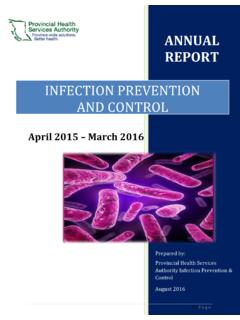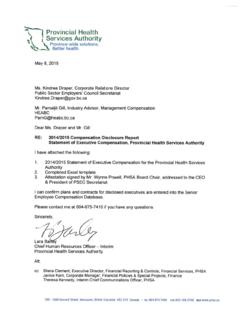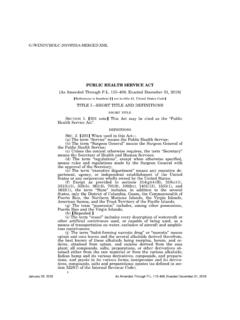Transcription of Standards and Guidelines for the Assessment and Diagnosis ...
1 Standards and Guidelines for the Assessment and Diagnosis of Young children with autism spectrum Disorder in British Columbia An Evidence-Based Report prepared for The British Columbia Ministry of Health Planning March 2003 Standards and Guidelines for the Assessment and Diagnosis of Young children with autism spectrum Disorder in British Columbia Primary Writer and Researcher: Vikram Dua, , (C) Child and Adolescent Psychiatrist, Department of Psychiatry, British Columbia s children s Hospital ASD Standards and Guidelines Working Group: Jo DiTommaso Infant Development Consultant Linda Eaves, Psychologist, Sunny Hill Health Centre Mary Francis, Public Health Nurse Diane Graham (OT), OT Reg.
2 ( ) Registered Occupational Therapist Helena Ho MDCM., (C) Developmental Pediatrician, Sunny Hill Health Centre Grace Iarocci, Researcher and Psychologist, Simon Fraser University Suzanne Jacobsen, Psychologist/Special Educator Candis Johnson Early Childhood Educator Pat Mirenda, Researcher, Faculty of Education, University of British Columbia P. N. Reebye, MBBS, DPM, MRC (Psych), FRCP(C) Child Psychiatrist, BC children s Hospital Donna Seedorf-Harmuth, Speech Language Pathologist Team Coordinator EIBI Program Glen Ward , (C) Pediatrician Expert Reviewers: Michael J. Guralnick , Director, Center on Human Development and Disability, University of Washington, Seattle, Washington Peter Szatmari, , (C), Child Psychiatrist, Department of Psychiatry, McMaster University, Hamilton, Ontario External Reviewers.
3 Margaret Brown Sandra Clark Lynnette Froese Mary-Ann Fulks Cyndi Gerlach Dan Galazka Marja Jorgensen Kathy O Connor Maureen O Donnell Carol Oosthuizen Elizabeth Payne Sheila Pretto Georgina Robinson Lynda Swain Lonnie Zwaigenbaum March 2003 Page 1 Standards and Guidelines for the Assessment and Diagnosis of Young children with autism spectrum Disorder in British Columbia 1 Introduction The field of autism has become of increasing interest to health, social service and education professionals in the last two decades. Dramatically rising rates of identification246 along with a rapidly changing research milieu has raised a number of pressing questions for government in terms of social policy, funding allocation, and health care initiatives.
4 As in other jurisdictions, autism services in British Columbia have been the subject of substantial concern and debate in the last decade. 34,272 In 1991, specific services for autism were first introduced in British Columbia as part of the Enhanced Initiatives for autism . In 1998, the BC Council on autism , representing key stakeholders, issued a brief indicating a crisis in autism services. This led to a workshop, out of which the Ministry for children and Families, the Ministry of Education, and the Ministry of Health produced the autism Action Plan (AAP) 13. The AAP, and its follow-up autism Action Plan Implementation Plan 14 made recommendations in four categories: 1) early intervention and treatment; 2) Assessment , Diagnosis , and eligibility; 3) education and training; and 4) transition to adult services.
5 A priority objective was to establish a common definition of autism , and common language, Assessment practices, and eligibility for autism services. Another priority was to enhance regional capacities to complete multidisciplinary assessments and diagnoses. The Ministry of Health Planning (MOHP) is coordinating with the Ministry of children and Family Development (MCFD) to provide a provincial program of effective early intensive intervention (EII) for children under age six with autism spectrum Disorder (ASD; see definition in Section 3). The Ministry of Health Services (MOHS) is responsible for Assessment and diagnostic services whereas the MCFD is responsible for treatment, training and research, and program evaluation.
6 The purpose of this document is to provide minimum Standards required in British Columbia to make a Diagnosis of ASD in children under the age of six; to assist in establishing eligibility for ASD intervention services; and to establish consistency in the ASD diagnostic process across the province. 2 Overview and Methodology The current Standards and Guidelines for the Assessment and Diagnosis of Young children with autism spectrum Disorder project was planned to ensure Assessment and diagnostic services for ASD in children six years old and under adhere to best practice, and are sustainable and practical in British Columbia. The document contains the following components: Introduction (Section 1); Overview and Methodology (Section 2); Definitions and Terminology (Section 3); Clinical Pathway for Diagnosis (Section 4); Surveillance and Screening (Section 5); Primary Care Assessment and Referral (Section 6); Diagnostic Multidisciplinary Assessment (Section 7); and, Recommendations for Education and Training (Section 8).
7 Sections 5, 6, and 7 are each divided into four parts: Preamble, Practice Standards , Clinical Practice Guidelines , and Outcome Objectives and Indicators. March 2003 Page 2 Standards and Guidelines for the Assessment and Diagnosis of Young children with autism spectrum Disorder in British Columbia The overall goal for the Standards and Guidelines for the Assessment and Diagnosis of Young children with autism spectrum Disorder is: to promote the application of evidence-based practices in the identification, Assessment and Diagnosis of children with ASD; to provide health regions with tools that support the identification, Assessment , and Diagnosis of children with ASD; and, to provide health regions and MOHS with an approach to monitoring outcomes.
8 This document is primarily directed at professionals involved in screening, identification, Assessment and Diagnosis of young children with ASD. This includes professionals involved in early intervention and education ( Infant Development Program (IDP) and Child Development Centre (CDC) workers, preschool educators), community health services ( primary care physicians, community health nurses, speech-language pathologists, occupational therapists), and other professionals involved in the Assessment and Diagnosis of children suspected of ASD ( psychologists, pediatricians, child psychiatrists, speech-language pathologists, occupational therapists). It is intended to be used as a reference document by provincial and regional health authorities in developing and expanding Assessment and diagnostic services for young children with query ASD.
9 This document is the culmination of a process that involved several steps. First, the research literature was reviewed and summarized (including primary research as well as several reputable expert consensus documents). Next, the evidence from the literature was organized into the areas defined by the project s objectives. Earlier drafts were revised to best reflect an evidence-based and practicable approach to assessing and diagnosing ASD in British Columbia. This report also represents the substantial contributions of the ASD Standards and Guidelines working group members. The working group members represented relevant professional associations, agencies and organizations from within , and each had experience and/or expertise with identification, Assessment or Diagnosis of ASD in children .
10 The working group reviewed three earlier drafts of this report, and provided substantive input in writing and in four telephone conference calls. Two expert reviewers, from outside , provided substantial feedback on the last draft of this report. A substantively larger group of external reviewers, invited based on their profession, experience, or expertise, also contributed input in one telephone conference call. Although this report is primarily an evidence-based document, to the greatest extent possible, an effort to reach consensus was an operating principle. It is critical that readers recognize that the focus for this document is children suspected of ASD six years old and under.















